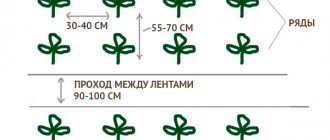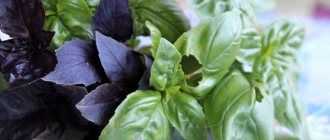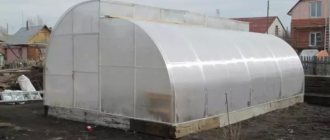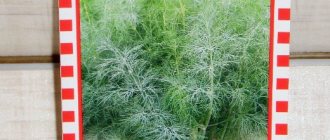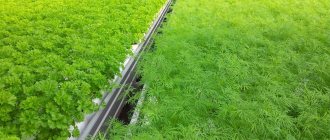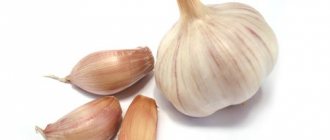A greenhouse has long become an indispensable attribute of any garden or summer cottage. It reliably covers tender early seedlings of peppers, eggplants and tomatoes until planting in a permanent place. In a greenhouse it is possible to grow several harvests of greenery and protect remontant raspberries from early autumn frosts that destroy their harvest. Any vegetable crop loved by the owners will take root in the greenhouse. But when deciding what to plant in the greenhouse along with tomatoes, it is worth considering the compatibility of the crops. Not all of them get along together.
Which varieties are best?
There are many varieties of basil, they differ in size, leaf color and aroma. Different varieties coexist well with each other and do not cross-pollinate, so several varieties can be planted at the same time.
The following varieties are best suited for growing in greenhouse conditions:
Purple basil is highly valued in Caucasian and Indian cuisine as a seasoning for sauces, side dishes, meat dishes and desserts. The leaves can be of various shades: from soft purple to rich dark purple.- Cinnamon is a compact plant with light green leaves that has the taste and aroma of cinnamon.
- Lemon is a spreading bush with lush foliage of a light green hue and the aroma of lemon.
- Camphor is a very beautiful plant with bright green foliage and exudes a pleasant clove aroma. This variety is most popular in Mediterranean cuisine.
What vegetables cannot be planted with tomatoes in the same greenhouse?
When growing tomatoes, it is imperative to control the temperature and humidity of the environment. That is why the correct choice of crops adjacent to tomatoes is very difficult - most vegetables do not feel comfortable next to tomatoes:
- Frequent watering and high humidity, which cucumbers love so much, are contraindicated for tomatoes;
- During growth, dill absorbs all the beneficial substances needed by tomatoes;
- young tomato seedlings will be suppressed by fennel;
- close proximity to peas is fraught with the fact that during the growth process they creep up to the tomatoes, wrap around them, and deprive them of light, so it is better to plant peas further away.
Neighborhood with some melons, such as pumpkins, squashes and zucchini, is also excluded. As they grow, they fill all available space.
How to prepare a greenhouse structure?
Depending on the region and its climatic conditions, the requirements for greenhouse construction depend. For example, for the central regions of Russia, when planting basil early, greenhouses made of glass or cellular polycarbonate are perfect. These materials transmit light and retain heat well.
The size of the greenhouse can be absolutely any, because in addition to basil, other crops can be grown there at the same time. It is best to place the structure in a sunny place, away from large trees. It is imperative to provide vents, as ventilation is indispensable.
You need to start preparing the greenhouse for the new season in the fall:
- Clear of plant debris.
- Wash all surfaces, remove cobwebs (if any), treat with a disinfectant.
- Partially replace the soil (you can remove the top layer and add humus, peat and sand) and dig everything up. The soil must be loose!
Next in the spring the following actions are needed:
- Loosen the soil and treat with copper sulfate.
- Add mineral fertilizers (complex).
- Form ridges
Greenhouse - into cells
What can you plant with cucumbers in a greenhouse?
To grow many types of plants in one greenhouse, it can be divided into zones using film, polycarbonate sheets, plywood or slate.
Important! In addition to the doors, at the beginning and end of the greenhouse there must be at least 2 windows located in the center.
It is equally important to choose the right material for zoning. For example, to keep the greenhouse warm in the evening, you can use sheets of dark slate, plywood or metal, since they warm up well during the day. If you need the room to be light enough, it is better to use film or polycarbonate.
Step-by-step instructions: how to plant?
Seeds
For good germination of basil seeds, they must be properly processed. Each seed of this plant is protected by a unique shell of essential oils, which can dissolve only in a favorable environment. Therefore, before planting it is worth doing the following manipulations:
Wrap the seeds in a cloth, pour hot water (about 50 - 60 degrees). Squeeze out excess water.- Wrap everything in a plastic bag and put it in a warm place (at least 25 degrees Celsius) for about 30 minutes.
- Unfold, the seeds should become covered with a slippery coating (the oils dissolve), then they can be sown in the prepared soil.
When sowing seeds, a certain order must be followed:
- Spill the soil (or filled containers) prepared in the fall with warm water.
- Make grooves with a depth of 0.5 cm to 1 cm at a distance of 30 cm from each other.
- Sow the seeds, leaving about 3 - 5 cm between them and mulch. Containers can be covered with film.
- After about 10 days, shoots will appear. As soon as 2 true leaves grow, the excess plants need to be removed, leaving a distance of about 10 cm between them.
Seedlings
Preparation of seedlings before planting in a permanent place is as follows:
- The temperature gradually decreases (you need to start reducing it 2 weeks before planting).
- Water with warm water (do not over-water).
When planting seedlings, the rules are as follows:
- It should be planted approximately a month after sowing the seeds (but no more than 45 days), and the bush should have 4–6 true leaves.
- There is no need to deepen the plants. Leave a gap of approximately 30–35 cm between the rows, and about 10–20 cm between the bushes (depending on the variety).
You will find all the details about basil seedlings in a separate article.
Transplanting
Once the plant variety has been selected, you can begin preparing the seeds. It is recommended to soak them in a growth stimulator or plain water for 8-9 hours.
The greenhouse with basil must be well ventilated
The grains should be planted in picking boxes that have been previously treated with some kind of disinfecting solution. An excellent solution would be 3% copper sulfate. Planting material should be planted in the ground 1-2 cm from the surface. This will allow the seeds to emerge into the light in a shorter time. As a rule, the first seedlings appear 5-6 days after planting.
Attention! To make seedlings appear faster, it is worth covering the ground with film. This approach ensures a more active growth process, increased temperature levels and moisture conservation.
At this stage, it is recommended to constantly water the basil. When the first shoots appear, soil irrigation should be done only as needed. The optimal duration of watering is only the first 2-4 weeks. Then it is recommended to completely protect the greens from moisture. Otherwise, there is a significant risk of blackleg formation.
When the first full-fledged leaf appears, the basil can be fed. For this, it is best to use a mineral composition. It is worth considering that the plant almost instantly acquires a rich, dark shade, since the crop is extremely responsive to the use of fertilizers. It is recommended to dissolve 3-4 g of ammonium nitrate and nitrogen fertilizer in 1 liter of water. The resulting amount of fertilizing will be sufficient for 3 square meters. m. soil. In this case, it is very important to ventilate the greenhouse. Otherwise, there is a high probability of spotting or powdery mildew.
Top shoots and inflorescences on basil must be removed
Care
To get a rich harvest, you need to properly care for basil, you need to create suitable comfortable conditions for it:
Temperature. Basil develops well at temperatures from 23 to 28 degrees. At temperatures below 15 degrees it may die.- Watering. Watering once a week will be enough. The most convenient way to do this is with a watering can with a wide spray nozzle or use drip irrigation.
- Weeding and loosening. It is imperative to remove weeds from the beds (by periodic weeding or manually). The plant is very responsive to loosening the soil.
- Humidity. Over-watering should not be allowed. If necessary, the greenhouse must be ventilated, but drafts cannot be created, they can cause great harm.
- Feeding. After the first cutting, be sure to water the plants well and apply fertilizer. You can use an aqueous solution of chicken manure or urea. Next, you should apply fertilizer after each cutting.
- Cutting. When the bushes reach a height of 20 cm, you can make the first harvest, that is, cutting (with pruners or a sharp knife), and you need to leave the stump with two leaves.
From one square meter per season you can get 2–7 kg of healthy aromatic greens.
Features of growing tomatoes in a greenhouse
Greenhouse tomatoes grown in proximity to other plants require their own microclimate. Good lighting is preferable for plants, but they also thrive in cloudy weather. The ambient temperature should be moderate and the room should be ventilated frequently. They need to be constantly fed with fertilizers and watered at the roots. Tomatoes need to be planted with plants with similar requirements.
Tomatoes vitally need fertilizers enriched with potassium and phosphorus. And excessive nitrogen content leads to the fall of the ovaries and a decrease in the amount of yield. Due to the frequent use of organic fertilizers, nitrates accumulate in fruits. Greenhouse neighbors of tomatoes should have similar requirements.
Sweet peppers in a greenhouse along with tomatoes
The correct choice of neighboring crops will help not only save space on the site, but also save energy and time for caring for plants. They will not transmit the same pests and diseases, nor will they have a depressing effect on each other. You can even arrange some semblance of symbiosis in the garden bed if you choose the right companions for the plants. It’s enough to figure out how to make a conveyor bed and what to plant next to the tomatoes in the greenhouse so that the plants feel comfortable.
Bad neighborhood
The following crops will be bad neighbors for it:
- Dill.
- Marjoram.
- Cabbage.
- Cucumbers.
- Radish.
- Ruta.
- Radish.
As a result, we can conclude that growing basil in a greenhouse is not at all difficult. Even novice gardeners get an excellent harvest; you just need to create suitable conditions for it: prepare the soil correctly, observe temperature and watering regimes, fertilize and loosen it in a timely manner. This royal herb is very responsive to attention and care and will certainly delight you with a bountiful harvest, its beauty and aroma. In a separate article you can learn when and how to harvest your basil.
If you decide to grow this aromatic plant, we suggest reading separate articles from which you will learn a lot of new and useful information about where to plant basil in order to get a good harvest and what are the features of cultivating this spice at home.
The best and worst predecessors
The spice will grow best in the place of crops for the development of which the soil was generously fertilized with minerals:
- legumes;
- zucchini;
- strawberry;
- cucumbers;
- nightshades (potatoes, tomatoes, eggplants).
What to plant after basil
The following will grow best after it:
- garlic;
- onion;
- zucchini;
- parsley;
- pumpkin;
- squash;
- potato.
What is the neighbor doing?
One day I noticed how unusual my neighbor’s property looked. She does not have a vegetable garden in the usual sense of the word. All crops are placed chaotically, and flowers and aromatic herbs are planted between the vegetables. This looks quite strange and very unusual. Meanwhile, the neighbor is getting an excellent harvest, especially tomatoes. One can only envy the tomatoes she grew.
Every year, a neighbor plants marigolds and basil in her tomato beds. At first I thought that she simply didn’t have enough space in the garden or that she wanted the beds to look like flower beds. But, as it turned out, the problem is not at all in the appearance of the garden, and certainly not in the lack of space.
Why do the leaves of purple basil turn black in the garden beds: reasons, what to do?
Important: If the leaves of the basil turn black, this indicates that the plant is infected with the fungal disease “blackleg”.
Your actions as a result of the formation of black leaves may be as follows:
- Review the irrigation system. Most often, the cause of the development of the disease lies in abundant watering.
- Loosen the soil. Creating soil that drains well will help save the situation.
- Getting rid of weeds. Regular weeding of basil is required. Weeds inhibit the growth and development of plants.
- Removing affected leaves and plants. If your entire basil bush turns black, get rid of it. Remove blackened leaves.
- Tilling the land with potassium permanganate. After uprooting the diseased plant, the earthen lump located under it is removed.
- A plot of land is watered with a solution of potassium permanganate.
These simple steps will help you save your basil harvest at the early stage of the disease. But if the disease has taken hold, fungicides will help to cope with it.
Preparations for processing basil:
- Fundazol
- Topaz
- Fitosporin
After the final harvest, the land will need to be additionally disinfected with a solution of potassium permanganate and dug up. Next year the basil should be planted in a different place.
Parsley
Curly or regular parsley are perfect for sowing in a tomato bed. These greens are quickly consumed for preparing salads and other dishes. When the tomatoes begin to actively develop and their long stems form a fairly dense shade, some of the remaining parsley bushes will be able to grow in new conditions.
Insect pests will attack tomatoes much less if there are parsley leaves emitting a spicy aroma nearby. For the same purpose, other green crops, such as mint and celery, can be planted in the garden bed.
Harvesting
When the plant reaches 10-15 cm, it can be cut off above 2 or 3 true leaves. Next, the row spacing is loosened and mineral fertilizing is applied. After 3 weeks, new shoots will appear from the leaf axils. In a good hot summer, 3-4 crops can be harvested from one bush. Harvesting is carried out before flowering, since during the appearance of inflorescences the shoots become rough and the leaves lose their rich aroma.
The harvest is stored dried and frozen
Important! Basil can be stored dried or frozen.
Basil is a very fragrant, healthy plant. Growing it in a greenhouse is not difficult. If you follow the planting and care rules, you can harvest 3-4 crops per season. The spice goes perfectly with meat dishes; it is used to prepare sauces, salads and side dishes.
